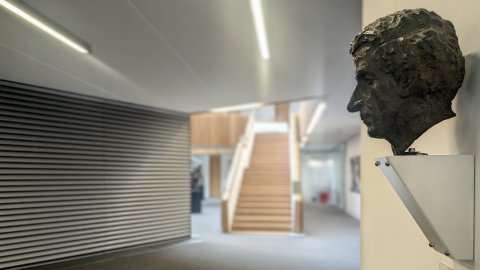Collective motion and environmental path entropy
Matthew Turner is a Professor in the Physics department, attached to the Complexity center, at Warwick University. He works on Biological and Soft Matter Physics, amongst other things.
Abstract
We study “bottom-up” models for the collective motion of large groups of animals. Similar models can be encoded into (micro)robotic matter, capable of sensing light and processing information. Agents are endowed only with visual sensing and information processing. We study a model in which moving agents reorientate to maximise the path-entropy of their visual environment over paths into the future. There are general arguments that principles like this that are based on retaining freedom in the future may confer fitness in an uncertain world. Alternative “top-down” models are more common in the literature. These typically encode coalignment and/or cohesion directly and are often motivated by models drawn from physics, e.g. describing spin systems. However, such models can usually give little insight into how co-alignment and cohesion emerge because these properties are encoded in the model at the outset, in a top-down manner. We discuss how our model leads to dynamics with striking similarities with animal systems, including the emergence of coalignment, cohesion, a characteristic density scaling anddifferent behavioural phenotypes. The dynamics also supports a very unusual order-disorder transition in which the order (coalignment) initially increases upon the addition of sensory or behavioural noise, before decreasing as the noise becomes larger.
16:00
The dispersion method and beyond: from primes to exceptional Maass forms
Abstract
16:00
The Metaplectic Representation is Faithful
Abstract
Iwasawa algebras are completed group rings that arise in number theory, so there is interest in understanding their prime ideals. For some special Iwasawa algebras, it is conjectured that every non-zero such ideal has finite codimension and in order to show this it is enough to establish the faithfulness of the modules arising from the completion of highest weight modules. In this talk we will look at methods for doing this and apply them to the specific case of the metaplectic representation for the symplectic group.
16:00
On entropy of arithmetic functions
Abstract
In this seminar, I will talk about a notion of entropy of arithmetic functions and some properties of this entropy. This notion was introduced to study Sarnak's Moebius Disjointness Conjecture.
16:00
Higher descent on elliptic curves
Abstract
Let $E$ be an elliptic curve over a number field $K$ and $n \geq 2$ an integer. We recall that elements of the $n$-Selmer group of $E/K$ can be explicitly written in terms of certain equations for $n$-coverings of $E/K$. Writing the elements in this way is called conducting an explicit $n$-descent. One of the applications of explicit $n$-descent is in finding generators of large height for $E(K)$ and from this point of view one would like to be able to take $n$ as large as possible. General algorithms for explicit $n$-descent exist but become computationally challenging already for $n \geq 5$. In this talk we discuss combining $n$- and $(n+1)$-descents to $n(n+1)$-descent and the role that invariant theory plays in this procedure.
16:00
Quantitative bounds for a weighted version of Chowla's conjecture
Abstract
The Liouville function $\lambda(n)$ is defined to be $+1$ if $n$ is a product of an even number of primes, and $-1$ otherwise. The statistical behaviour of $\lambda$ is intimately connected to the distribution of prime numbers. In many aspects, the Liouville function is expected to behave like a random sequence of $+1$'s and $-1$'s. For example, the two-point Chowla conjecture predicts that the average of $\lambda(n)\lambda(n+1)$ over $n < x$ tends to zero as $x$ goes to infinity. In this talk, I will discuss quantitative bounds for a logarithmic version of this problem.
16:00
Computing Tangent Spaces to Eigenvarieties
Abstract
Many congruences between modular forms (or at least their q-expansions) can be explained by the theory of $p$-adic families of modular forms. In this talk, I will discuss properties of eigenvarieties, a geometric interpretation of the idea of $p$-adic families. In particular, focusing initially on the well-understood case of (elliptic) modular forms, before delving into the considerably murkier world of Bianchi modular forms. In this second case, this work gives numerical verification of a couple of conjectures, including BSD by work of Loeffler and Zerbes.


